Using the James Webb Space Telescope, an international team led by scientists from the Centro de Astrobiología in Spain, including astronomer Alexander de la Vega of the University of California, Riverside (UCR), has discovered the most distant barred spiral galaxy, ceers-2112, observed to date. This groundbreaking find challenges prior assumptions about galaxy evolution, revealing that galaxies may have become orderly much earlier than previously believed, thus necessitating revisions to theoretical models of galaxy formation and evolution.
In what was previously thought impossible, barred spiral galaxies like the Milky Way could not be observed before the universe, which is estimated to be 13.8 billion years old, reached half of its current age. However, the discovery of ceers-2112 shows that such galaxies existed early on, forming as soon as after the Big Bang. This finding suggests that galaxies in the early universe could have been as structured and orderly as the Milky Way, defying the commonly held belief that galaxies were much more chaotic.
According to coauthor de la Vega, a postdoctoral researcher in the Department of Physics and Astronomy at UCR, ceers-2112 possesses a distinctive bar structure that is typically found in spiral galaxies like the Milky Way. As a result, this discovery forces a revisiting of the current understanding of galaxy formation and evolution. The implications of this find go beyond mere scientific curiosity, as it challenges two fundamental aspects of our understanding of the universe.
Theoretical models will have to accommodate galaxies becoming stable enough to host bars very early in the universe’s history, prompting adjustments related to the rate at which bars form and the role of dark matter in early galaxies. Moreover, the discovery of ceers-2112 confirms that structures like bars can indeed be detected in galaxies from the distant past. This is particularly significant given that galaxies in the early universe were smaller, making the finding of these structures much more challenging.
De la Vega’s role in the research includes estimating the redshift and properties of ceers-2112 and contributing to the interpretation of the measurements. Surprisingly, the properties of the galaxy’s bar were better understood than expected. Notably, the discovery of ceers-2112 is expected to pave the way for more such finds in the early universe. The power of the James Webb Space Telescope was pivotal in this discovery, along with the expertise of the research team, challenging the perceptions of galactic evolution, and opening new avenues for understanding deep space.


